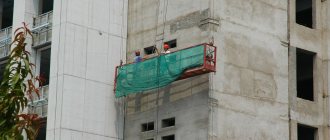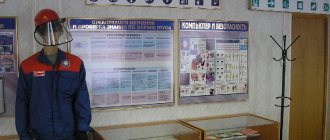Factors
Safe organization and maintenance of the workplace is characterized by the following parameters:
- temperature, exchange, air humidity, illumination, cleanliness, operating mode;
- the state of labor discipline;
- dimensions of the production site, equipment, production inventory (racks, containers, stands);
- the specific placement of inventory, equipment, labor objects (units, workpieces, parts) and tools that ensure rational movements of the employee;
- the contents of the workplace together with the devices and tools that are needed to implement the technological process;
- the presence of production, accounting and technical documentation: drawings, process maps, work order instructions, tool book, brand;
- providing the workplace with workpieces, parts, materials, technical control, repair of fixtures and equipment if necessary.
What are the different positions of a security guard?
In order to properly organize a security guard's workplace, you must first select its type and structure.
According to the method of observation, they are distinguished:
- stationary posts (the guard does not leave his place during the shift);
- mobile posts (the guard makes constant rounds of the territory or premises, according to the schedule).
According to the operating mode, they are distinguished:
- permanent posts (24-hour daily schedule with rotation of employees);
- temporary posts (work only at certain times of the day or on certain days of the week).
By location:
- external posts (in structures standing separately from the main facility);
- internal posts (in a common room inside the facility);
- internal with partial separation from the general space (cabins, enclosures, fences, partitions, reception desks).
By type of layout:
- standard posts (space dimensions about 2x2.5 m with one window and one door);
- multifaceted posts (booths with all-round visibility through windows placed in a circle);
- vestibule posts (with a passage for visitors);
- post-passage posts (corridor with a room for a security guard, head of service, as well as primary amenities);
- floor posts (for high-altitude views).
Significance of the process
Keeping a safe workplace has a positive impact on productivity.
The results of statistical studies indicate that with proper organization of the workplace, you can count on high-quality and efficient work by the employee.
After analyzing work processes, it was found that the most advantageous position is a sitting position. That is why the rules for maintaining a workplace include the issue of placing seats in production, where the force is about 5 kg. If the working force exceeds 10 kg, work should be performed only in a standing position.
In case of equal convenience between two provisions, the employee has the right to independently choose one of them.
Why is it necessary?
Cleaning the workplace in production is not only necessary to make it look neat. Its main goal is to maintain cleanliness and comply with sanitary and hygienic standards.
Another goal of cleaning is ensuring the safety of employees . If the site is cluttered, there is a risk of injury on the job.
A misplaced angle grinder or jackhammer can cause serious injury.
Dusty rooms increase the likelihood of developing infectious and allergic diseases. For example, metal shavings and wood dust can damage the mucous membrane of the eyes, skin and respiratory system.
Important information
Keeping the workplace clean is a must. All tools, devices, finished and processed products must be placed so that the worker spends a minimum amount of time on their laying, installation, and removal.
There are certain requirements for the maintenance of the workplace, according to which the axis of the employee’s body must coincide with the work area.
The maximum number of movements that he makes must be within the normal working zone. The movements made by the employee must involve minimal effort. A variety of devices are suitable for this, which speed up and facilitate the procedure for performing the required amount of work. All movements are assumed to be rhythmic and simple.
Workplace maintenance is a way to increase labor productivity while increasing product quality.
General terms
The maintenance of the workplace must comply with health standards, as well as the most efficient use of employee energy. Standards for air temperature, air circulation, placement of inventory and equipment, and room illumination have been developed.
When designing workplaces, the requirements of technical aesthetics must be taken into account. If the inventory and equipment meet the aesthetic requirements in color and shape, you can count on a significant simplification of human labor.
Technical equipment of the security post
The technical means of the security post, in addition to personal protective equipment and equipment, include:
- means of controlling external mechanical blocking structures (sliding gates, wickets);
- controls for sensors and alarm systems;
- video surveillance system controls;
- warning system controls;
- ACS system management tools;
- controls for frame metal detectors;
- controls for turnstiles and other internal barrier devices;
- means of controlling the backup power system (generators, backup lines, etc.);
- means of communication and communications;
- computer equipment (monitors, keyboards, headsets, etc.).
In addition, the security post must be equipped with portable means and a fire extinguishing system, and at special category facilities - with chemical protection means.
Modern requirements
What is workplace organization? The maintenance of workplace organization is a prerequisite for increasing the efficiency of employees. In addition to muscular costs, the load on a person’s visual-nervous apparatus increases significantly during work. With rational, ergonomic design of workshops, using reasonable coloring of inventory and equipment, it is possible to increase the tone of workers and increase labor productivity with minimal energy costs.
The correct selection of colors helps reduce fatigue and is considered an excellent prevention of conflicts in the workplace.
Sanitary and hygienic requirements for the workplace
Maintaining an optimal indoor microclimate is regulated in SanPiN 2.2.4.548-96. This regulatory document describes the requirements for the need to maintain optimal temperature and relative humidity, as well as the need to maintain a ventilation system that ensures a balance of fresh air inflow and outflow. At the same time, it is important to observe the noise level of the fans and regularly refuel the air conditioners.
Important! Lighting recommendations are described for individual workplaces.
Selection of materials
Statistical studies conducted in production have confirmed the possibility of increasing labor productivity by 15-20 percent if the above factors are observed.
Green-blue and yellow colors have a positive effect on the central nervous system. It is advisable to paint the upper part of the walls, ceilings, and window blocks in light shades: cream, white, blue. Light colors reflect more than half of the sunlight, so there is a significant saving in electrical energy. It is recommended to paint panels used on walls in light green. Fixed parts of modern equipment should be painted green, and moving parts should be painted yellow or cream.
The racks installed in production workshops match the color of the main equipment. Contrasting shades are chosen for levers and buttons on control panels.
Hazard warnings in different colors
In order to prevent the likelihood of industrial injuries and maintain safe working conditions, some elements are painted in warning colors:
- yellow;
- orange;
- red.
Yellow color is used to designate those parts and materials that can be pushed, pinched, or on which a worker can hit or suffer serious injury. For example, this color is used to paint transport and lifting equipment, monorails, trolleys, cranes, and the first and last steps of stairs. To enhance the effect, alternating yellow and black stripes are used.
Red color is a signal of increased danger, a warning about the possibility of fire. It is used when painting brake devices, fire-fighting equipment, and prohibition signs.
The orange tint is used to designate parts and mechanisms that can injure workers. It is used when painting sharp edges, internal surfaces, and open parts of machines, contact with which can lead to electric shock.
Orange color is suitable for warning about the possibility of radiation exposure.
Green color is allowed for safe materials, exit doors, and medicine cabinets.
| Friday, 02/05/2021, 10:14 Welcome Guest | RSS | ||
| Home | Registration | Entrance | ||
| Car maintenance and repair Find out everything about the car |
Locksmith's workplace
Technical equipment of the workplace
Workplace organization
Workplace maintenance rules
General information about labor safety when performing plumbing work
Basics of industrial sanitation
Fire prevention measures
1.Technical equipment of the workplace
A workplace is understood as part of the production area of a workshop, site or workshop, which is assigned to a specific employee or employees in the case of shift work in a specific production.
The workplace is intended for performing work of a certain type and must be equipped with equipment, devices, tools and materials necessary for their implementation.
The main equipment of a mechanic's workplace is, as a rule, a single workbench with a vice installed on it.
The workbench must be strong and stable, its height must correspond to the height of the worker.
If the height of the vice does not correspond to the height of the worker, they are adjusted with a lifting and lowering screw or a wooden grid is placed on the floor, which should fit snugly to the floor and not slip.
To protect workers from possible injuries when performing operations involving the formation of chips, a replaceable protective screen made of mesh or organic glass is installed on the workbench.
The following types of bench vices are most widely used when performing metalwork work: chair vice, parallel (rotary and non-rotating) and high-speed pneumatic vice.
Chair vices have a very limited area of application.
They are designed to perform heavy-duty work involving high impact loads, such as chopping, bending, riveting.
The most common type of vice used in metalworking is the parallel rotary bench vice.
The vice is called parallel because when the movable jaw moves, it remains parallel to the fixed jaw in all positions.
The vice consists of a base plate and a rotating part.
The movement of the movable jaw is ensured by a screw pair (lead screw and lead screw nut), and the parallelism of this movement is ensured by a guide prism.
To rotate the upper part of the vice relative to the base plate, it is necessary to loosen the bolts using the handle, then when the upper part of the vice is rotated around the axis, the nut and bolt will move freely in the circular T-shaped groove.
After installation in the desired position, the upper part of the vice is secured with a handle.
2. Organization of the workplace
At the workplace there must be working and control instruments necessary to perform a given operation.
There are certain requirements for the placement of tools, workpieces and materials at the workplace:
• at the workplace there should be only those tools, materials and workpieces that are necessary to perform this work;
• tools and materials that the worker uses frequently should be located closer to him, to the right and left, within a radius of approximately 350 mm;
• tools and materials used less frequently should be located within a radius of approximately 500 mm;
• tools and materials used extremely rarely should be located in remote areas. Their reach is ensured only when the worker’s body is tilted.
3. Rules for maintaining the workplace
Due to the fact that the rational organization of the workplace and the correct placement of tools and materials during the work process play a significant role in ensuring its quality, the rules listed below should be observed.
Before starting work you must:
• check the serviceability of the workbench, vice, devices, individual lighting and mechanisms used in the work;
• read the instructions or technological map, drawing and technical requirements for the work to be done;
• adjust the height of the vice according to your height;
• check the availability and condition of tools, materials and workpieces used in the work;
• place on the workbench the tools, workpieces, materials and devices necessary for the work.
During work it is necessary: • to have on the workbench only those tools and devices that are currently in use (everything else should be in the drawers of the workbench);
• return the used tool to its original place;
• constantly maintain cleanliness and order in the workplace.
Upon completion of work you must:
• clean the tools from shavings, wipe them, put them in cases and put them in the drawers of the workbench;
• clean the workbench tabletop and vice from chips and dirt;
• remove unused materials and workpieces, as well as processed parts, from the workbench;
• turn off individual lighting.
4. General information about labor safety when performing plumbing work
Accidents most often occur as a result of inattention to the implementation of occupational safety instructions and internal regulations, as well as as a result of insufficient acquisition of the necessary production skills and lack of experience in handling tools and equipment.
The task of safety precautions is to prevent accidents and create conditions that would ensure complete safety of workers and their productivity.
To ensure safe performance of work, a number of rules must be followed:
• work only with serviceable and sharpened tools;
• When working on sharpening machines, be sure to use safety glasses or a protective screen with a lock. Do not allow grinding wheels to beat. Monitor the serviceability of exhaust devices;
• cutting in a vice should only be done if there is a protective mesh or screen on the workbench;
• work in a hat and overalls;
• lift heavy parts only with two people. Do not place heavy parts on the edge of the workbench;
• do not blow away sawdust, do not brush away the shavings with your hand, but use a broom brush for this;
• before starting to work on machines and power tools, check them at idle speed and only after that secure the tool;
• work only in good lighting;
• when working with electrified tools from a mains voltage above 36 V, be sure to use rubber gloves and a rubber mat;
• operate machines only if there are proper guards for moving parts;
• after working with oils, lubricants and cooling liquids, acids, alkalis, soda, fluxes, adhesives, etc., be sure to wash your hands with hot water and soap;
• if you receive minor injuries, be sure to treat the wound with iodine and apply a bandage;
• work using acids, alkalis, fluxes, etc., as well as work associated with the release of dust, smoke, gases, must be performed in a well-ventilated area or under an exhaust hood;
• do not go out into a draft when hot after work;
• when performing work, observe all labor safety rules specified in the instructions and process sheets.
5. Basics of industrial sanitation
Industrial sanitation involves the creation of conditions in production that ensure the required temperature in production premises, good ventilation, sufficient illumination of workplaces, absence of drafts, and the presence of auxiliary and household premises.
The temperature in the production room must be maintained within 16...20°C.
Ventilation of industrial premises should ensure the creation of comfortable working conditions by maintaining the required temperature conditions, removing harmful gases, vapors and dust.
Ventilation can be supply or exhaust.
One of the indicators of the required sanitary condition of a room is its illumination.
Optimal lighting in the workplace should reduce eye strain, making work easier and reducing the possibility of injury.
Lighting can be either natural (daylight) or artificial (electric lighting).
Natural lighting is preferred.
In addition to general hygiene rules, the personal hygiene of the employee is of great importance.
Personal hygiene refers to measures aimed at maintaining health, preventing and eliminating conditions that can lead to poor health.
To maintain health and prevent diseases it is necessary:
• take short breaks during work to relieve fatigue (in addition, you should keep in mind that after working while standing, you need to rest while sitting, and vice versa);
• get at least 8 hours of sleep per day;
• during work, change your working position from time to time;
• after finishing the working day, wash your entire body in the shower with soap.
6. Fire prevention measures
To prevent fires, it is necessary to constantly keep the workplace clean and tidy;
Lubricants must not be left at workplaces; they must be stored in special places;
To avoid spontaneous combustion of oily rags and the occurrence of a fire, put them in special metal boxes;
Electric incandescent lamps must be covered with shades;
It is prohibited to use faulty electrical appliances that have exposed wires, weak wire connections, as well as faulty electrical sockets and switches;
At the end of the work, you should check whether the switches, electrical appliances, and lighting fixtures are turned off;
If a fire occurs, it is necessary to call the fire brigade and, before its arrival, extinguish the fire using the available primary fire extinguishing means;
In the event of a fire, glass in the windows should not be broken, as this creates drafts that increase the size of the fire;
During a fire, it is important to remain calm and follow the instructions of the administration;
Fire extinguishers are used to extinguish a fire.
The most widely used fire extinguishers are:
OCP (chemical foam fire extinguisher) - the charge consists of two parts, acidic and alkaline, jet length is 6 m, action time is 60 seconds. Designed for extinguishing flammable and combustible liquids and solids. Not used for alkali metals and carbides, liquids with a density lower than water. Fire extinguishers are recharged annually, regardless of application.
CO (carbon dioxide fire extinguisher) - a cylinder is filled with liquefied carbon dioxide under a pressure of 7 MPa, when the valve is opened, the volume increases 500 times, and the temperature drops to -70, the length of the jet is 2-3 meters, the duration of action is 30-40 seconds. Designed for live electrical installations, valuables and materials. Do not use alcohol, acetone, celluloid, or magnesium for extinguishing.
OUB (carbon dioxide-bromoethyl fire extinguisher) - charged with a mixture of 97% ethyl bromide and 3% carbon dioxide, it is used like OU, but has a number of advantages. They do not freeze when the fire extinguishing agent moves through the valve and have a significantly lower pressure (0.9 MPa), the productivity is 4 times higher than that of the OS.
OP (powder fire extinguisher) - a fire extinguishing powder charge, which is supplied with compressed air, which is in a can under a pressure of 0.8 MPa, the action time is 30 seconds, it is universal in use;
The number after the letters in the stamp indicates the capacity of the cylinder in liters, OU-5 (5 liters)
A fire extinguisher that has a seal and a test date tag is suitable for use.
Fire extinguishers of the OU, OUB, OP brands are checked by weighing as the extinguishing agent is consumed.
Fire water supply can be external or internal.
External – FIRE RESERVOIRS and FIRE HYDRANTS. Indicated by special signs.
Internal fire hydrants (IP) are located inside buildings and are equipped with trunks for connecting fire hoses.
Labor protection work
Immediately after employment, the new employee is given induction training at the workplace. Its content depends on the specifics of the enterprise.
According to Article 216 of the Labor Code of the Russian Federation, the responsible employee (labor safety specialist) and the director of the enterprise are required to make explanatory recommendations that relate to specific activities.
What is safety precautions in an enterprise?
Requirements for the workplace are described in the Labor Code of the Russian Federation, SanPiN and local regulatory documents of the organization. Their compliance is monitored by a labor protection engineer.
With a well-planned workspace, an employee will be able to show the best results and achieve their goals and objectives within the established time frame. In this case, the workplace must meet a number of parameters.
The maximum permissible threshold for noise level in the workplace is within 80 dB. To reduce noise and vibration emitted during operation, special sound-absorbing surfaces and shock-absorbing pads are used for the equipment that is the source of noise.
Substrates and foundations are also used to reduce vibrations.
Important! For certain professions, the level of noise and vibration is calculated individually. For example, for a train driver, excavator driver, boiler and pump house worker, the maximum permissible values are higher, but representatives of professions are entitled to an additional payment for this.
An optimal microclimate must be maintained in the working area of each worker. If the work is predominantly sedentary and does not require significant physical exertion, then the recommended temperature in winter should not fall below 22-24 degrees. In summer, the optimal temperature ranges from 23-25 degrees.
Air speed – 0.1 m/s.
If the employer is unable to provide the specified conditions, then the duration of the working day should be reduced, and sometimes the work process may be completely suspended in accordance with Sanitary Rules and Norms 2.2.4.3359-16 dated June 21, 2016 No. 81.
The secretary is the first assistant to the director of the organization. Its place should not only represent the well-being of the company, but also be as functional as possible. The reception area is divided into 2 zones: a working area and a waiting area for visitors.
Secretary's workplace
The list of necessary things for a secretary's workplace includes:
- table and chair;
- cabinet or rack for documentation;
- additional (auxiliary) table.
The furniture is arranged in such a way that the worker can quickly get from one corner of the room to another.
Next, you need to take care of the availability of a telephone, computer, copy machine, printer and other office equipment, depending on the type of activity of the company.
Important! The secretary's workplace should be located in such a way that the visitor can immediately see him and ask questions. It is important that the secretary is able to notice the client from afar.
These are rules whose compliance guarantees the life and health of workers at a specific production facility. Occupational safety and health is the responsibility of the employer, which is imposed on him by a number of regulations, including:
- Labor Code;
- Federal Law of July 24, 1998 No. 125-FZ;
- Federal Law of December 28, 2013 No. 426-FZ;
- Order of the Ministry of Labor dated December 29, 2014 No. 1197;
- Government Decree No. 1160 dated December 27, 2010 and a number of others.
Occupational safety (OSH) is associated with the prevention and prevention of injuries and occupational diseases. At the end of 2021, 4,479 serious accidents were recorded in Russia, 1,158 people died. The Ministry of Labor in its message did not specify who is to blame for the deaths of workers, but, as a rule, the main cause of death is the human factor.
- save the lives of yourself and other workers;
- not to violate the law and not to cause harm to people’s health with subsequent administrative (Article 5.27 of the Code of Administrative Offenses) or criminal liability (Article 143 of the Criminal Code of the Russian Federation);
- do not violate labor discipline and maintain all benefits and additional payments at the workplace;
- keep your job, since violation of safety regulations by the Labor Code of the Russian Federation provides for termination of the employment contract (Article 81 and Article 192 of the Labor Code of the Russian Federation).







